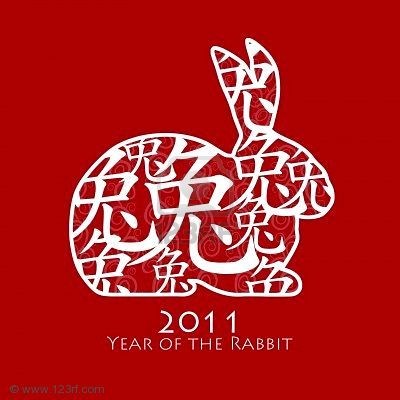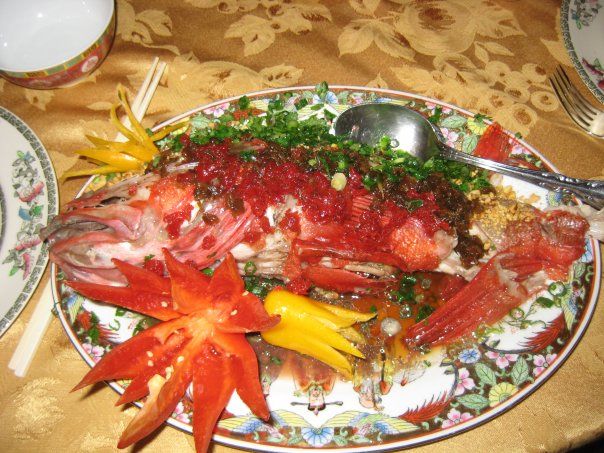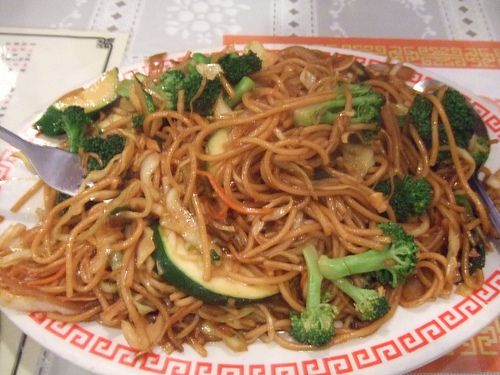We’re a day late (blame atrocious Boston weather) but we’re wishing a happy Year of the Monkey to all who celebrate Lunar New Year! Eat some dumplings and share a book from this list of titles featuring the holiday, all recommended by The Horn Book Magazine and The Horn Book Guide.
Picture books
 Set in long-ago China, Ying Chang Compestine’s The Runaway Wok tells of Ming Zhang and his poor but deserving family. On New Year’s Eve, Ming buys a magical wok, which promptly sets out to transfer riches from the greedy Li family to the Zhangs, who share it with others. The detailed, vigorous illustrations by Sebastià Serra reflect the mischievous wok’s energy. A recipe and Chinese New Year festival facts are appended. (Dutton, 2011)
Set in long-ago China, Ying Chang Compestine’s The Runaway Wok tells of Ming Zhang and his poor but deserving family. On New Year’s Eve, Ming buys a magical wok, which promptly sets out to transfer riches from the greedy Li family to the Zhangs, who share it with others. The detailed, vigorous illustrations by Sebastià Serra reflect the mischievous wok’s energy. A recipe and Chinese New Year festival facts are appended. (Dutton, 2011)
 Also by Ying Chang Compestine, Crouching Tiger stars Vinson, whose grandfather, visiting from China, calls him by his Chinese name, Ming Da. Grandpa teaches his impatient grandson the slow, careful exercises of tai chi, and eventually he and Ming Da play a pivotal role in the Chinese New Year parade. Yan Nascimbene’s realistic, luminous watercolor illustrations show the family’s balance of the traditional and the modern. (Candlewick, 2011)
Also by Ying Chang Compestine, Crouching Tiger stars Vinson, whose grandfather, visiting from China, calls him by his Chinese name, Ming Da. Grandpa teaches his impatient grandson the slow, careful exercises of tai chi, and eventually he and Ming Da play a pivotal role in the Chinese New Year parade. Yan Nascimbene’s realistic, luminous watercolor illustrations show the family’s balance of the traditional and the modern. (Candlewick, 2011)
 In Yu Li-Qiong’s A New Year’s Reunion, Little Maomao and her mother prepare both for Chinese New Year and for her father’s annual return home (he works far away). Zhu Cheng-Liang’s harmonious gouache paintings use lots of red and bright colors. This award-winning import is an excellent introduction to Chinese New Year in China and a poignant, thoughtful examination of the joys and sorrows of families living apart. (Candlewick, 2011)
In Yu Li-Qiong’s A New Year’s Reunion, Little Maomao and her mother prepare both for Chinese New Year and for her father’s annual return home (he works far away). Zhu Cheng-Liang’s harmonious gouache paintings use lots of red and bright colors. This award-winning import is an excellent introduction to Chinese New Year in China and a poignant, thoughtful examination of the joys and sorrows of families living apart. (Candlewick, 2011)
 In Bringing in the New Year by author/illustrator Grace Lin, a Chinese American girl describes her family’s preparations for the Lunar New Year. Her impatience for the big moment moves the story along until the dragon dance, depicted on a long foldout page, finally ushers in the new year. Illustrations featuring Lin’s signature clean, bright gouache patterns accompany the tale. An appended spread supplies additional information about the holiday. A board book edition was published in December 2013. (Knopf, 2008)
In Bringing in the New Year by author/illustrator Grace Lin, a Chinese American girl describes her family’s preparations for the Lunar New Year. Her impatience for the big moment moves the story along until the dragon dance, depicted on a long foldout page, finally ushers in the new year. Illustrations featuring Lin’s signature clean, bright gouache patterns accompany the tale. An appended spread supplies additional information about the holiday. A board book edition was published in December 2013. (Knopf, 2008)
 Counting book Ten Mice for Tet by Pegi Deitz Shea and Cynthia Weill offers a simple description of the activities surrounding the celebration of Tet, the Vietnamese lunar new year (“1 mouse plans a party / 2 mice go to market”). A section at the back provides facts about the holiday and explains the importance of the details in Tô Ngọc Trang and Phạm Viết Ðinh’s vibrantly colored embroidered art. This playful look at a cultural tradition can be used with a wide age range. (Chronicle, 2003)
Counting book Ten Mice for Tet by Pegi Deitz Shea and Cynthia Weill offers a simple description of the activities surrounding the celebration of Tet, the Vietnamese lunar new year (“1 mouse plans a party / 2 mice go to market”). A section at the back provides facts about the holiday and explains the importance of the details in Tô Ngọc Trang and Phạm Viết Ðinh’s vibrantly colored embroidered art. This playful look at a cultural tradition can be used with a wide age range. (Chronicle, 2003)
 Mary Dodson Wade’s humorous folktale adaptation No Year of the Cat explains why the Chinese calendar uses specific animal names for the twelve years. The emperor, bemoaning that “we cannot recall the years,” devises a race — the first twelve animals to finish will have a year named after them. Both text and the ornate illustrations by Nicole Wong give personalities to each of the animals, the emperor, and his devoted advisors. (Sleeping Bear, 2012)
Mary Dodson Wade’s humorous folktale adaptation No Year of the Cat explains why the Chinese calendar uses specific animal names for the twelve years. The emperor, bemoaning that “we cannot recall the years,” devises a race — the first twelve animals to finish will have a year named after them. Both text and the ornate illustrations by Nicole Wong give personalities to each of the animals, the emperor, and his devoted advisors. (Sleeping Bear, 2012)
 In The Race for the Chinese Zodiac by Gabrielle Wang, the ancient Jade Emperor tells thirteen animals that they will race; the “first twelve animals to cross the river” will have a year named after them. The animals line up and, each in its own unique fashion, cross the river. Sally Rippin’s Chinese-ink, linocut, and digital-media illustrations are exuberant and fluid, evoking mood and furthering the whimsical tone of this retelling. (Candlewick, 2013)
In The Race for the Chinese Zodiac by Gabrielle Wang, the ancient Jade Emperor tells thirteen animals that they will race; the “first twelve animals to cross the river” will have a year named after them. The animals line up and, each in its own unique fashion, cross the river. Sally Rippin’s Chinese-ink, linocut, and digital-media illustrations are exuberant and fluid, evoking mood and furthering the whimsical tone of this retelling. (Candlewick, 2013)
 In Janet S. Wong’s This Next New Year, a spare narrative enhanced by Yangsook Choi’s festive, richly colored illustrations relates a Chinese-Korean boy’s reflection on what Chinese New Year means to him. By sweeping last year’s mistakes and bad luck out of the house, he hopes to make room for “a fresh start, my second chance.” Concepts of renewal, starting over, and luck will resonate with young readers in this imaginative appreciation of the emotional aspects of the holiday. (Farrar/Foster, 2000)
In Janet S. Wong’s This Next New Year, a spare narrative enhanced by Yangsook Choi’s festive, richly colored illustrations relates a Chinese-Korean boy’s reflection on what Chinese New Year means to him. By sweeping last year’s mistakes and bad luck out of the house, he hopes to make room for “a fresh start, my second chance.” Concepts of renewal, starting over, and luck will resonate with young readers in this imaginative appreciation of the emotional aspects of the holiday. (Farrar/Foster, 2000)
 Natasha Yim’s entertaining Goldilocks takeoff Goldy Luck and the Three Pandas is set during the Chinese New Year celebration, when Goldy Luck takes a gift to her panda neighbors. Familiar incidents follow — featuring (rice) porridge, a broken chair, and a nap — all portrayed with zest in the illustrations by Grace Zong. In an ending that suits the setting, Goldy has second thoughts and returns to apologize. New Year facts and a turnip cake recipe are included. (Charlesbridge, 2014)
Natasha Yim’s entertaining Goldilocks takeoff Goldy Luck and the Three Pandas is set during the Chinese New Year celebration, when Goldy Luck takes a gift to her panda neighbors. Familiar incidents follow — featuring (rice) porridge, a broken chair, and a nap — all portrayed with zest in the illustrations by Grace Zong. In an ending that suits the setting, Goldy has second thoughts and returns to apologize. New Year facts and a turnip cake recipe are included. (Charlesbridge, 2014)
Intermediate fiction
 For Taiwanese-American Pacy, sorting out her ethnic identity is important, and she wonders what she should be when she grows up. Writing and illustrating a book for a national contest makes her think that perhaps she can become an author of a “real Chinese person book.” In The Year of the Dog, author/illustrator Grace Lin offers both authentic Taiwanese-American and universal childhood experiences, told from a genuine child perspective. (Little, Brown, 2006)
For Taiwanese-American Pacy, sorting out her ethnic identity is important, and she wonders what she should be when she grows up. Writing and illustrating a book for a national contest makes her think that perhaps she can become an author of a “real Chinese person book.” In The Year of the Dog, author/illustrator Grace Lin offers both authentic Taiwanese-American and universal childhood experiences, told from a genuine child perspective. (Little, Brown, 2006)
 Sequel The Year of the Rat brings major change for Pacy, as her best friend moves away. Pacy also starts doubting her resolution to become a writer/illustrator. Lin deftly handles Pacy’s dilemmas and internal struggles with sensitivity and tenderness, keeping a hopeful and childlike tone that will inspire empathy. Appealing line drawings appear throughout. (Little, Brown, 2008)
Sequel The Year of the Rat brings major change for Pacy, as her best friend moves away. Pacy also starts doubting her resolution to become a writer/illustrator. Lin deftly handles Pacy’s dilemmas and internal struggles with sensitivity and tenderness, keeping a hopeful and childlike tone that will inspire empathy. Appealing line drawings appear throughout. (Little, Brown, 2008)
 Artie brags to his tough cousin Petey about providing all the fireworks for Chinese New Year in The Star Maker. With time running out before the celebration, Artie’s uncle Chester makes a gracious sacrifice to help his nephew save face. The easy-to-follow story introduces readers to Chinese New Year traditions. Author Laurence Yep’s preface explains that the 1950s-set tale is based on his own childhood memories. (HarperCollins/Harper, 2011)
Artie brags to his tough cousin Petey about providing all the fireworks for Chinese New Year in The Star Maker. With time running out before the celebration, Artie’s uncle Chester makes a gracious sacrifice to help his nephew save face. The easy-to-follow story introduces readers to Chinese New Year traditions. Author Laurence Yep’s preface explains that the 1950s-set tale is based on his own childhood memories. (HarperCollins/Harper, 2011)
Nonfiction
 In Ying Chang Compestine’s alphabet book D Is for Dragon Dance, each letter is accompanied by one or two sentences very briefly introducing an aspect of the Chinese New Year celebration — I for incense, J for jade, K for kites. Chinese characters in various calligraphy styles make an eye-catching background for the attractive textured illustrations by YongSheng Xuan. An author’s note offers a few more facts as well as a dumpling recipe. (Holiday, 2006)
In Ying Chang Compestine’s alphabet book D Is for Dragon Dance, each letter is accompanied by one or two sentences very briefly introducing an aspect of the Chinese New Year celebration — I for incense, J for jade, K for kites. Chinese characters in various calligraphy styles make an eye-catching background for the attractive textured illustrations by YongSheng Xuan. An author’s note offers a few more facts as well as a dumpling recipe. (Holiday, 2006)
 With colorful photographs and simple, informative text, Celebrate Chinese New Year by Carolyn Otto details the traditions and rituals of Chinese New Year, including travel, family, gifts, plentiful food, and decorations. The use of “we” throughout feels welcoming and inclusive. Appended are instructions for making a Chinese lantern, a recipe for fortune cookies, and information on the Chinese calendar. (National Geographic, 2008)
With colorful photographs and simple, informative text, Celebrate Chinese New Year by Carolyn Otto details the traditions and rituals of Chinese New Year, including travel, family, gifts, plentiful food, and decorations. The use of “we” throughout feels welcoming and inclusive. Appended are instructions for making a Chinese lantern, a recipe for fortune cookies, and information on the Chinese calendar. (National Geographic, 2008)
 A suitable addition to any multicultural holiday collection, Nina Simonds and Leslie Swartz’s collection Moonbeams, Dumplings and Dragon Boats: A Treasury of Chinese Holiday Tales, Activities and Recipes includes folktales, recipes, and activities for celebrating Chinese New Year and the Lantern Festival, Qing Ming and the Cold Foods Festival, the Dragon Boat Festival, and the Mid-Autumn Moon Festival. Accompanying the stories and activities are Meilo So’s stylized watercolors, some of which evoke the brushwork of Chinese calligraphy. (Harcourt/Gulliver, 2002)
A suitable addition to any multicultural holiday collection, Nina Simonds and Leslie Swartz’s collection Moonbeams, Dumplings and Dragon Boats: A Treasury of Chinese Holiday Tales, Activities and Recipes includes folktales, recipes, and activities for celebrating Chinese New Year and the Lantern Festival, Qing Ming and the Cold Foods Festival, the Dragon Boat Festival, and the Mid-Autumn Moon Festival. Accompanying the stories and activities are Meilo So’s stylized watercolors, some of which evoke the brushwork of Chinese calligraphy. (Harcourt/Gulliver, 2002)
The post Happy Year of the Monkey! appeared first on The Horn Book.










